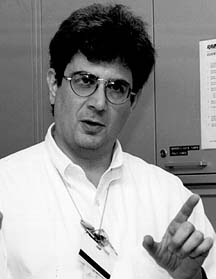 Dr. Edythe D. London, Director of NIDA's new Brain Imaging Center, initiated the craving study that has found links between cue-induced craving and the brain structures involved in memory. A pharmacologist, she began brain imaging research in 1979 and came to DIR in 1981.
Dr. Edythe D. London, Director of NIDA's new Brain Imaging Center, initiated the craving study that has found links between cue-induced craving and the brain structures involved in memory. A pharmacologist, she began brain imaging research in 1979 and came to DIR in 1981.For years, drug abuse researchers have known that when addicts are exposed to drug-related cues, such as the sight of drug paraphernalia or even a drug-using companion, these stimuli can spark powerful drug craving. Using brain-imaging techniques, scientists are literally seeing the changes that these environmental cues trigger in the brain as they are taking place.
Researchers in NIDA's Division of Intramural Research (DIR) have recently published brain imaging findings that show that cue-induced drug craving is linked to distinct brain systems that are involved in memory. (For more on using imaging to study craving, see NIDA-Supported Researchers Use Brain Imaging to Deepen Understanding of Addiction)
"Drug craving is a central aspect of addiction and poses an obstacle to treatment success for many individuals," says NIDA Director Dr. Alan I. Leshner. "Twenty years of neuroscience research have brought us to where we can actually see increases in specific brain activity that are linked to the experience of craving. If we can understand the mechanisms that cause craving in people addicted to cocaine or other drugs, more effective treatment strategies can be developed that counteract craving."
 Dr. Steven Grant is lead investigator on the craving study. The study continues with the latest PET imaging scanner at the Center, probing how drug-related cues may disrupt normal memory functions.
Dr. Steven Grant is lead investigator on the craving study. The study continues with the latest PET imaging scanner at the Center, probing how drug-related cues may disrupt normal memory functions.Using positron emission tomography (PET), Dr. Edythe D. London and her colleagues at DIR's Addiction Research Center (ARC) in Baltimore produced brain images showing that, in people who have used cocaine, cocaine-use cues spark increased glucose metabolism in brain regions that are associated with memory. Increased glucose metabolism indicates enhanced neural activity. By questioning the volunteers whose brains were scanned, researchers correlated computer-screen images with the cocaine users' responses about intensity of craving sensations. To make the correlation, the brain images were examined for color changes that are calibrated to show areas of increased glucose metabolism.
In the study, DIR researchers compared metabolic activity in the brains of 13 volunteers who had used cocaine with activity in the brains of a control group of 5 volunteers who had never used cocaine. The scans were taken after the groups were exposed to both cocaine-related cues and neutral cues. The cocaine-related stimuli consisted of observing drug paraphernalia and viewing a videotape of cocaine users.
The cocaine-user group responded to the cocaine-related cues, but not to the neutral cues, with increased glucose metabolism, which was visible in the PET images and with their own reports that they were experiencing craving. The greater the reports of craving, the greater the metabolic activity in three key areas of the brain, the researchers found. The volunteers who had never used cocaine reported no cocaine cue-induced craving and showed no visual signs of cue-induced brain activity.
Among the brain regions activated by the cocaine cues were the dorsolateral prefrontal cortex, amygdala, and cerebellum, which are all involved in aspects of memory and learning. The amygdala has been linked to emotional aspects of memory. The findings suggest that a neural network involving these brain regions integrates the emotional and cognitive aspects of memory and reacts to environmental cues and memories by triggering cocaine craving.
"These three areas show cue-induced activity changes that are highly correlated with the behavioral measure, which is craving," says Dr.London, Director of the NIDA Brain Imaging Center and initiator of the study."Thus, we have identified brain circuits that may be targets for pharmacotherapy or other treatments. We now have a practical system for testing potential interventions. This system overcomes the limitations of an addict's own subjective evaluations of craving sensations by using the PET scanner to see, objectively, actual responses within the brain that correlate to craving."
 PET scans conducted at NIDA's Brain Imaging Center reveal selective activation of brain circuits during cocaine craving. Scans from volunteers who experienced a high level of cue-induced cocaine craving show activation of brain regions implicated in several forms of memory. The scans at right show activation of the dorsolateral prefrontal cortex (DL), which is important in short-term memory, and the amygdala (AM), which is implicated in emotional influences on memory. When these volunteers were exposed to neutral (non-drug-related) cues, this activation was not seen (scans at left).
PET scans conducted at NIDA's Brain Imaging Center reveal selective activation of brain circuits during cocaine craving. Scans from volunteers who experienced a high level of cue-induced cocaine craving show activation of brain regions implicated in several forms of memory. The scans at right show activation of the dorsolateral prefrontal cortex (DL), which is important in short-term memory, and the amygdala (AM), which is implicated in emotional influences on memory. When these volunteers were exposed to neutral (non-drug-related) cues, this activation was not seen (scans at left).Until now, the three brain regions identified by the researchers have been associated with memory functions, but not with drug craving, says Dr. Steven Grant, the study's lead investigator. These new findings support the hypothesis that memory may be more critical to drug craving than is the traditional concept of reinforcement. "The amygdala, which is involved in giving memories emotional color, puts an emotional aspect on the cue-induced craving sensations," he adds.
The current research into cue-induced craving continues with new PET scanning equipment recently installed at the ARC. (See New Imaging Center Enhances NIDA's Brain Research)
Dr. London and her colleagues are using the new scanner to test whether cue-induced craving impairs an addict's ability to perform simple daily tasks. Preliminary findings confirm the hypothesis that cues can intrude into working memory functions, producing distracting daydreams or cocaine-oriented thoughts, says Dr. Grant. "Activation, by drug-related cues, of brain regions that integrate the emotional and cognitive parts of memory could contribute to one of the hallmarks of addiction-the excessive focus on activities that lead to further drug use," Dr. London says.
Sources:
- Grant, S.; London, E.D.; Newlin, D.B.; Villemagne, V.L.; Liu, X.; Contoreggi,C.; Phillips, R.L.; Kimes, A.S.; and Margolin, A. Activation of memory circuitsduring cue-elicited cocaine craving. Proceedings of the National Academyof Sciences 93:12040-12045, 1996.
- London, E.D., et al. Cocaine-induced reduction of glucose utilization inhuman brain. Archives of General Psychiatry 47:567-574, 1990.
- Stapleton, J.M., et al. Cerebral glucose utilization in polysubstance abuse.Neuropsychopharmacology 13(1)21-31, 1995.